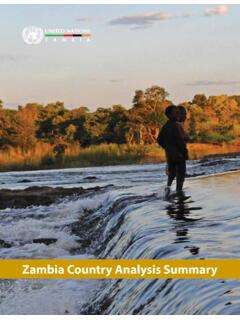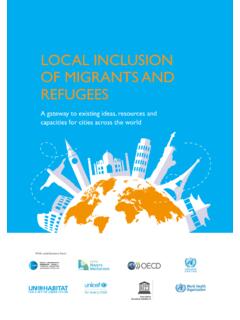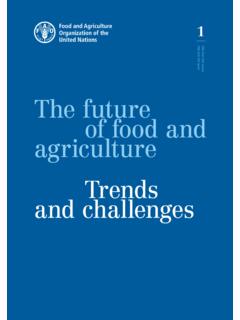Transcription of Families and Inclusive Societies in Africa - United Nations
1 Families and Inclusive Societies in Africa By Monde Makiwane and Chammah J Kaunda, Human Sciences Research Council, South Africa Introduction Besides being a central aspect to the 16th sustainable development goals (SDG 16) and their achievement, promoting Inclusive Societies may also be regarded as the bedrock of the other objectives and targets of the SDG 16, including peace, justice and strong and Inclusive institutions. The problems that SDG 16, among others, seek to redress have identifiable and strong connections to the absence of socially Inclusive Societies , social formations, structures and institutions. Underlying this, is the absence of equal opportunities for every member and group in society irrespective of their origins, background, class, ethnicity, race, gender and other markers of identity. Yet, equal opportunities is, perhaps, the essential defining element of an Inclusive society, and makes it possible for all members of a society to fully attain their human potential ( United Nations Department of Social Affairs - UNDESA, 2009).
2 It provides the necessary conditions for every member of society to participate in every aspect of social life economic, cultural, political, civic and all, and provides the platform for engaging and ending exclusion and poverty (UNDESA, 2009). However, at the heart of any society and the attainment of any sustainable developmental objectives in a societal context, is the family and its recognition as a fundamental social institution, where the building of a society begins (Carlson, 1999). The African family charters unambiguously recognize the family institution as a foundation of society. This is in line with the International Conference on Population and development (ICPD). guiding principles, which recognized the family as the basic unit of society, and thus Societies are encouraged to strengthen this institution. The African Charter on Human and People's Rights as well as other regional and country specific charters also endorses the family as the natural unit, foundational basis and pillar of society (Department of Social development - DSD, 2012).
3 The African Charter further urges states to take care of family health and morale (Organization of African Unity - OAU, 1982). Although in the African charters there is a call for recognition of traits that have always been associated with the traditional African family, the fact that Families on the continent have diversified both in form and in their function, has also been acknowledged. It is thus important to begin by demonstrating how the notion of African family has evolved. African Perspectives on Family The diversity of family formations in Africa is clearly illustrated by the expansive definitions of family in African family charters, which accommodate both the traditional African family and emerging family forms. While Family and household are sometimes used interchangeably, because of their close relationship to each other, in most African Societies they are likely not to connote the same social unit.
4 It is common for members of the same family (including members of the same nuclear family or a member of an extended family that functions as a close unit) to straddle more than one household. In turn, members of the same household are likely not to be of the same nuclear family. In Black South Africa , for instance, children are taken care of by an extended family who are not necessarily biological parents. Thus, in 2012 some 531 000. orphaned children were cared for by foster parents, most of whom are members of the extended family who in turn receive social assistance from the government. According to the Department of Social development , approximately 80% of foster carers are extended family members (South African Institute of Race Relations, 2013, p. 660). Family in the African context often refers to what in western terms would be the extended family. A family is generally constituted by three processes, which are blood relations, sexual unions or adoption.
5 Societally sanctioned sexual unions between (two and in cases of polygamous unions, which are not uncommon in Africa , more than two) adults, and on the other hand, blood relations in Africa typically constitute wider relationship than those that are characteristically in western nuclear Families . African Families are typically extended to aunts, uncles, grandparents, cousins and other relatives that form a family that functions in unison. The broad concepts of family in many African Societies is illustrated in Mandela's autobiography Long Walk to Freedom where he states, My mother presided over three huts at Qunu, which as I remember, were always filled with babies and children of my relations. In fact, I hardly recall any occasion as a child when I was alone. In African culture, the sons and daughters of one's aunts and uncles are considered brothers and sisters, not cousins. In several African communities, family is not limited to space and time, thus, it cuts across generations, relatives living far and near, the living and those who have joined the ancestors, as well as the ancestors themselves who continue to play a role in the lives of the living (Lugira, 2009).
6 This may be viewed as a very Inclusive family system, which models the broader Inclusive nature and type of African communities, creating a family-like lens through which several social actors are included and relationships interpreted. Obligations to wider kin vary with time, and typically more widely invoked during times of crises, or during certain life cycle events such as funerals and this remains a common practice in extended Families on the continent, despite social change. Other dimensions of the family institution and systems in Africa , as observed by Therborn (2006) which offer both challenges and opportunities for SDG 16 in Africa include the strong patriarchal nature of such systems, with different levels of sexual permissiveness; the common practice of polygamy, and the cultural significance of family lineages and fertility. While patriarchy have negative implications for justice and gender equality, understanding the values associated with lineage and fertility and how this shapes notion of family, inclusion and exclusion in terms of belonging and access to resources could enhance efforts towards achieving Inclusive Societies .
7 For instance, children are highly desired in many African communities and loved, and their presence have far-reaching consequences for social status, respect, quality of life, perception and veneration of an individual in life and death. Thus, infant mortality and infertility are among the worse tragedies to befall an individual, the family and lineage (Siegel, 1999). Siegel (1999) also notes that lineage in the African family context is not only biological, nor is it always objectively genealogical, but can be sociological as well. This means that lineage and kinship can be edited. People can be inserted, or insert themselves into certain lineages, often symbolically, but in a very meaningful and effective way. In addition, the notion of family often expands and depending on place and context, non-blood relations and other kinds of relationships may assume familial significance and meaning. Families are expanded through marriages, for instance, and it is also not uncommon for a close friendship to mature into family', or a friend to be named, regarded and treated as family in acknowledgement of length of friendship and felt levels of closeness, trust and reliability.
8 This is one way through which the family is linked to the broader community. As Siqwana-Ndulo (1998) stated, the institutions of family, marriage and household in African Societies revolved around community. Thus, not only is the family formation broader, its function is grossly enhanced by being interlocked with the general community. Although the salience of family ties may be situational, they are rarely entirely lost, and often, take priority over certain kinds of ties in many instances, despite changes brought about by modernisation that sometimes create a rift between family members. The usefulness of these lasting family ties is often seen in the ways deportees are able to easily reintegrate into their Families . Siegel (1999) cites the example of the over one million Ghanaian migrants deported from Nigeria in the 1980s, who, while western aids agencies planned intervention, reintegrated into their Families and communities within two weeks.
9 This is also seen among African deportees from several parts of the world. As stated above, in recognizing both traditional and contemporary family forms, the charters did not imply a homogenous static institution but acknowledge that social changes have affected African family formations and structures over time. Thus, it expressed a need for family policies to acknowledge and embrace adaptations in Families . The overview of Families in Africa reveals that significant adaptations have happened over the years, brought about by a number of factors, which include globalisation, modernisation, migration and the HIV/AIDS pandemic. Nevertheless, multi-generational and extended Families remain the most common family structure among the majority of the African people. Unfortunately, the recognition of African family in policy documents has not been translated into social policies and programmes that take into cognizance the African extended Families that has increasingly been influenced by mobility.
10 Increasing mobility and migration have been such that there are fewer co-residing primary family units. Thus, Families may live far apart or be dispersed across national borders and stretched kinship networks across vast geographic space' (Turner, 2002, p. 397). As Richter and Amoateng (2003) urge [G]iven the range of possibilities for family formations, accepting this multiplicity of social relations within and across households would offer an improved understanding of livelihood strategies and more accurate theorising of contemporary South Africa 's social terrain. Thus, it is important to analyse the ways in mobility is shaping African understanding of family. Family Movements and Challenges Mobility is a broad concept of human movement that includes movements between dwellings or households even if it is within the same place. On the other hand, migration , in its classic usage, connotes a permanent movement between two clearly demarcated areas.













